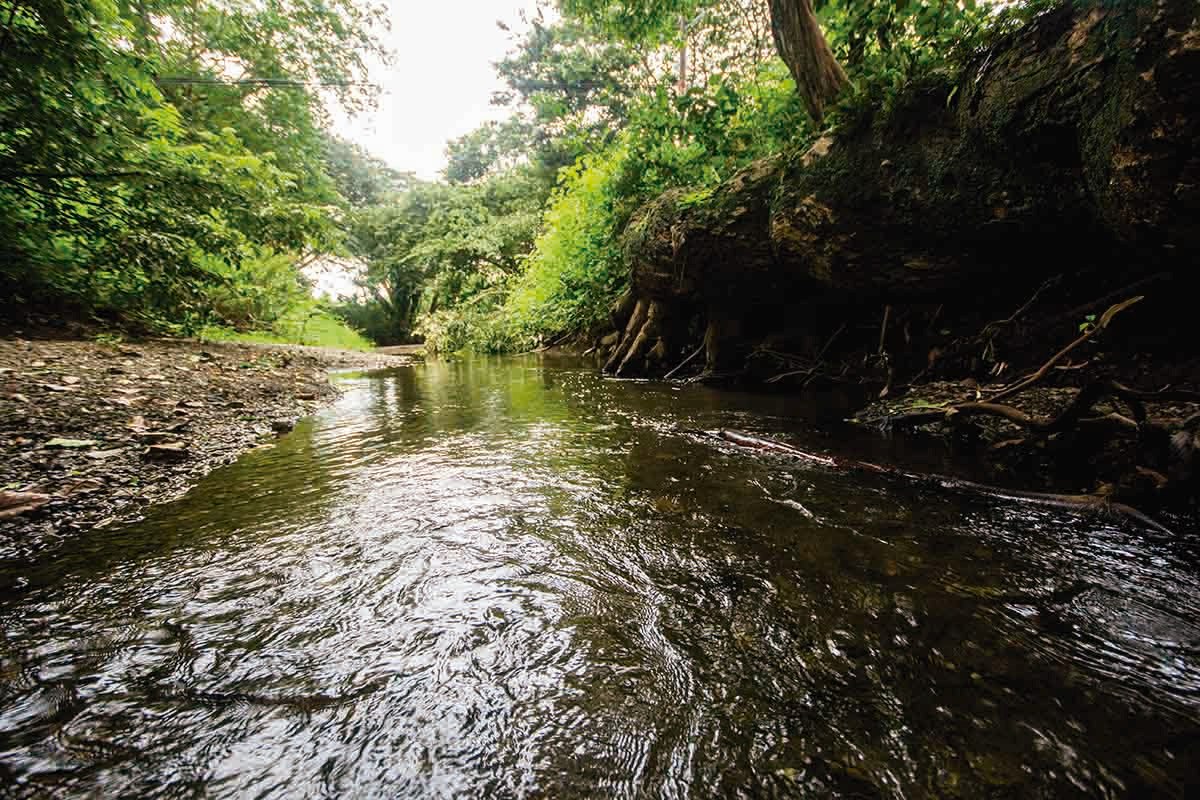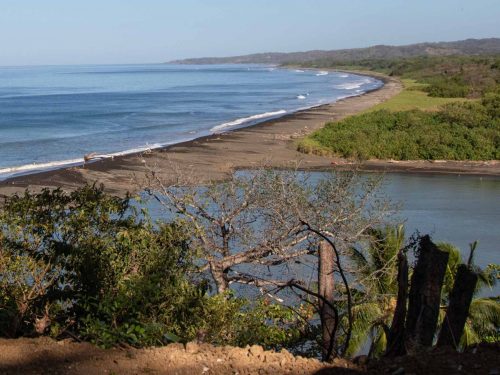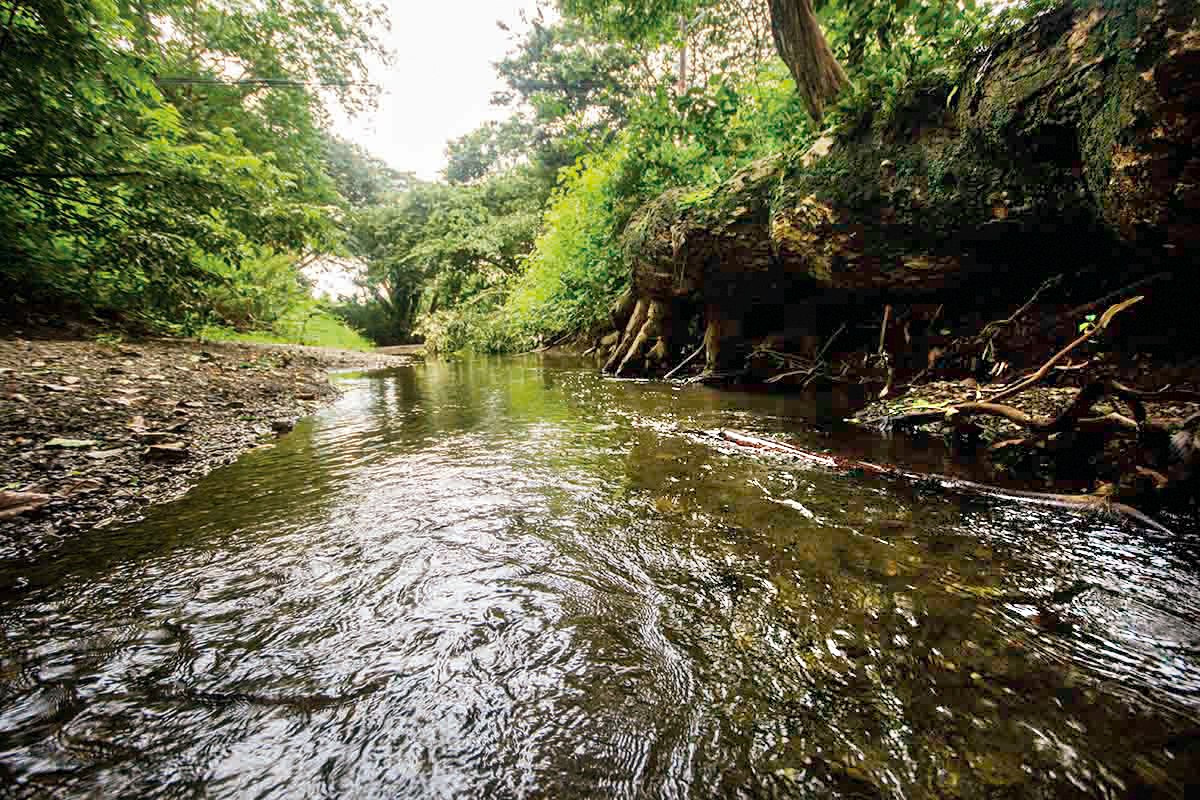
A foul smell coming from the Lagarto River in Samara has some neighbors convinced that wastewater running into the river is polluted, but despite denunciations filed against area businesses suspected of polluting the river, to date nothing has been confirmed.
In light of continued doubt, The Voice decided to take a sample of the water coming out of the drainage pipe into the riverbed next to the bridge between Cangrejal and downtown and send it to the water microbiology lab of the University of Costa Rica (UCR) for analysis. This was done on June 6. The results showed levels of fecal matter in excess of 1600 per 100 mL. By comparison, non-chlorinated water with values equal to or above 1.8 are not considered potable.
The current MINAE regulation for residual waters, last modified in 2007, establishes a limit of no more than 1000 fecal coliforms per 100mL for residual waters drained from hospitals or other health establishments, or for ordinary wastewaters of any origin that are drained into a body of water used for recreational activities of primary contact. However, the Lagarto River is not classified as primary contact.
Marilyn Mora, from the office of the Direction of Water of MINAE in San Jose, said that the regulation does not clearly define what is considered primary contact, although swimming could be an example. She also stated that a lot of debate has taken place regarding how to take fecal matter into account in the regulation.
“Fecal coliforms don’t necessarily indicate pollution; rather they can be associated with other microorganisms,” she explained. “Coliforms can appear in anything and not necessarily in ordinary water.”
Dr. Fulvio Paniagua Acuña of the Samara EBAIS clinic assured that so far he hasn’t seen any cases of illnesses as a result of coliforms, noting that not many people swim in that particular estuary. However, he cautioned that any contact with polluted water can be dangerous since the contaminants can easily be transferred from someone’s hand to their mouth, provoking symptoms such as diarrhea or digestive problems. He also noted that the river flows into the ocean, so the wastewaters are also polluting the ocean water.
Paniagua did report about 8 cases so far this year of illnesses caused by drinking water with parasites or amebas, which affects the intestines and can cause anemia in children.
Where Does the Contaminated Water Come From?
The only types of water that can be discharged into a river are rainwater and treated water. Mora said that the Pali supermarket in Samara is the only business who has a permit on record with the Direction of Water to divert water into the Lagarto River.
Neighbor Victor Manuel Perez Campos, who works in reception and maintenance at Hotel Villas Pepitas, down the road from Pali, noticed the foul smell of the water coming out of the tube and due to this, he called the Ministry of Health previously to report contamination and accompanied officials to show them the tubes. He believes the source is Pali. “I have been working here for six years and I saw when Pali installed all of these tubes here,” attested Perez Campos.
Villas Pepitas is another business that is occasionally mentioned as a possible source. Regarding this business’ wastewater disposal, Perez Campos said they have eight apartments connected to five septic tanks with drainage within the property and assured that the drainage doesn’t go to the river.
Zinnia Cordero Vargas, director of the Nicoya Ministry of Health, said that officials responded to a complaint in June of 2011 and inspected Palí’s wastewater treatment plant. “The Samara Palí has a treatment plant that discharges into the Lagarto River, and the operational reports submitted before this institution meet the maximum discharge limits,” Cordero told The Voice in December of 2012.
The Voice sent the results from the UCR lab analysis to the Ministry of Health. Inspector Kenia Herrera Espinoza, in a report dated July 26, indicated that the most recent technical report of residual waters from Pali’s treatment plant, dated April 4, 2013, also meets established limits. In addition, Herrera indicated that in this case fecal coliform analysis is not required under the regulation for residual waters.
In general, however, Herrera explained to The Voice that the presence of fecal coliforms in water could affect health, depending on many factors such as the type of contact, if the water is ingested, and the physical condition of the person.
The Voice also sent the analysis results to Walmart, the parent company that owns Pali. Yolanda Fernandez, manager of corporate issues for Walmart Costa Rica, responded, “Walmart of Mexico and Central America complies with the legal regulations with reference to treatment of wastewaters. In the specific case of your consultation, we are reviewing the processes of this store to continue guaranteeing our commitment to the environment.”
What About Other Businesses Along the Street?
There are actually two drainage tubes, one above the other, directed into the Lagarto River, as well as a larger tube. The contaminated water sample was taken from water coming out of the upper tube. No water was observed coming from the lower tube.
Eduardo Arnaez, the water administrator for Samara, said he was not surprised by the results of the UCR lab report. He confirmed that one of the tubes emptying into the river is from Pali and the other from Condominio Plaza Samara, often called the Century 21 building, although he wasn’t sure which tube belongs to which building.
The Voice requested to see the wastewater treatment plants of both businesses. Although a tour of the Pali plant was never arranged, the managers of Condominio Plaza Samara showed The Voice their plant and provided a copy of the latest inspection of the treatment plant. The treatment plant has a capacity for 21 units, explained property manager Melissa Marin, but currently there are only six units, only one of which is occupied full-time, so in effect the treatment plant’s tank is never full enough for residual water to actually come out of it.
The Voice was able to see that the tanks for the last two stages of the treatment plant process were dry. “We work very hard to keep it clean and turn reports into [the Ministry of] Health on time,” she assured.
According to the last report, dated May 27, 2013, “the system and in particular each one of the unitary processes function optimally.” The report notes that residual waters from the treatment plant are disposed of in Rio Lagarto.
The treatment plant was inspected by Sandro Ureña Hernandez, a private biotechnology engineer. The Voice talked with Ureña, who confirmed that the plant is very large and has very little water in it. He said that the plant did have a problem when the blower stopped functioning, but it was repaired and a new one was installed so the plant now has two blowers.
There are about 20 buildings along both sides of the street between the corner of Main Street and the Lagarto River. Laura Rebeschini, owner of Viva Verde Laundry, another business on the same street, agreed that “where it (the polluted water) comes from must be found.” Her business was denounced at the end of 2012 as a possible source of the contamination and was inspected by the Ministry of Health, after which they rebuilt and enlarged the drainage system of their septic tank. The Voice saw this work taking place. “In March, we made a large drainage, much larger than what we needed,” commented Rebeschini. “It was done so there is no doubt that the water doesn’t leave here.”







Comments